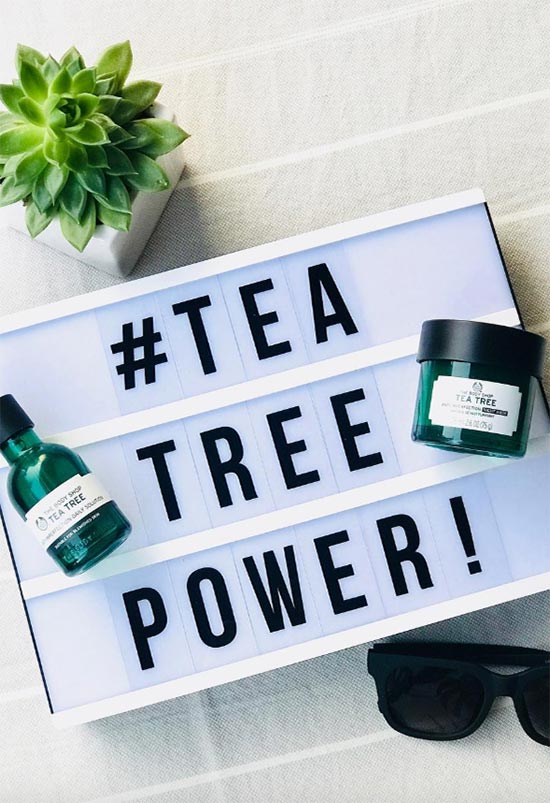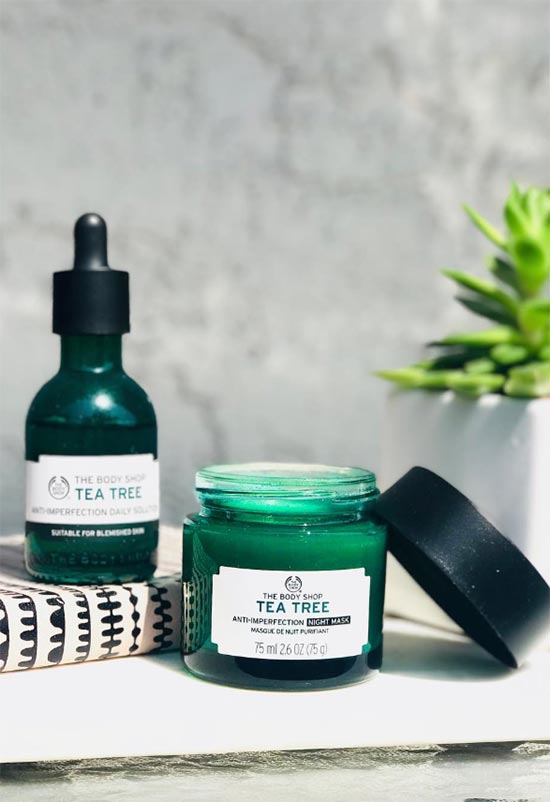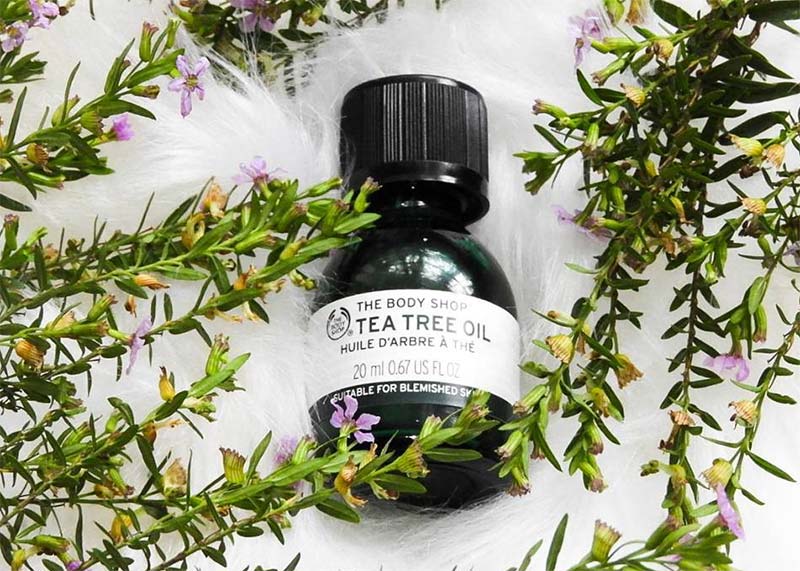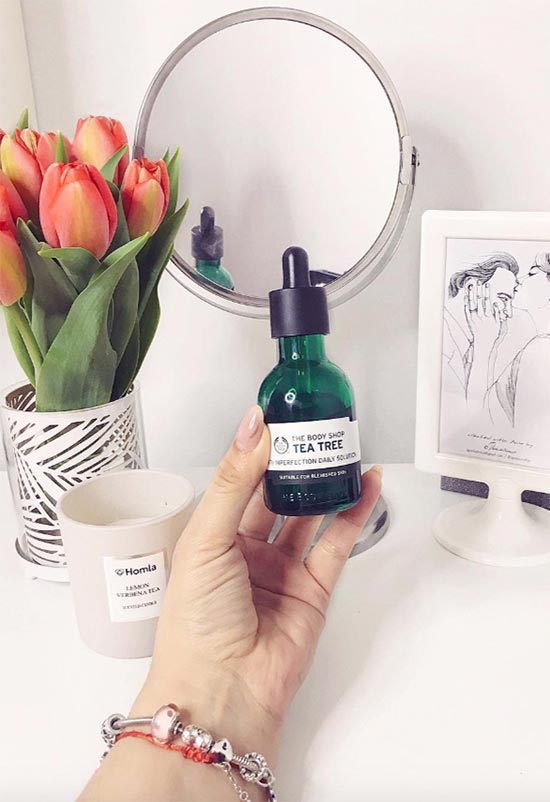Tea tree oil has long been touted as a cure for all kinds of skin ailments. If you are a fan of all things natural, you might be especially familiar with this particular essential oil. In this article, we will explain what tea tree oil is, how it is produced, and how it works on the skin. We will examine the evidence and help you decide for yourself if tea tree oil is the acne solution you need.
We’ll list all of the tea tree oil benefits for skin, along with its potential side effects, so you know how to use it safely. We’ll explain the difference between tea tree oil and green tea extract, and finish off with some suggestions for how to use tea tree oil at home with some DIY recipes.
In this article:
- What Is Tea Tree Oil?
- Tea Tree Oil Skin Benefits
- Side Effects of Tea Tree Oil Skin Products
- Tea Tree Oil vs. Green Tea Extract
- How to Use Tea Tree Oil for Acne
What Is Tea Tree Oil?
Tea tree oil is a type of essential oil, meaning that it is a thin liquid comprised primarily of fragrance compounds. Tea tree oil comes from the leaves of the melaleuca alternifolia tree, which is native to Australia.
The leaves undergo a steam distillation process that separates the fragrance compounds, to create the powerful essential oil. This essential oil has medicinal, camphoraceous odor that can be instantly recognized.
Tea tree oil was first commercialized in the 1920s after an Australian named Arthur Penfold decided to investigate various aboriginal remedies. The Australian aboriginals used a paste made of the leaves as an ointment to apply to wounds, and also gargled a tea made of tea tree leaves in order to alleviate throat ailments.
These days, this essential oil is frequently used in skin care since it is reputed to seriously help with acne as well as other skin issues. This is likely because of the particular aromatic compounds found in tea tree oil.
Tea tree oil is primarily comprised of terpinen-4-ol, γ-terpinene, and α-terpinene. These fragrance compounds are known to have antibacterial and anti-fungal effects, which explain why tea tree oil seems to clear up acne so well.

The evidence that tea tree oil helps with acne because of its antibacterial properties are largely anecdotal, since there is very limited research. Because of this I hesitate to see that tea tree oil is antibacterial, but I can certainly say that if you prefer using natural products or if other topical acne medications haven’t helped your skin, you can certainly give tea tree oil products a try to see if it’ll help. You can also use it in conjunction with other acne fighters like benzoyl peroxide or salicylic acid.
Tea Tree Oil Skin Benefits
- First and foremost, tea tree oil is known as an acne-fighter. Research is limited, but there is evidence that a 5% solution of tea tree oil can work just as well at reducing breakouts as 5% benzoyl peroxide. This is because of the unique fragrance compounds that are found in this essential oil.
- Tea tree oil is also said to help with fungal infections, including athlete’s foot, malassezia, and dandruff. While this has not been conclusively proven, and does not make it a good replacement for anti-fungal medications, you can still add a bit to your creams or shampoo for some extra help.
- Some people find that diluted tea tree oil also helps alleviate redness, itchiness, and irritation associated with sensitivities or rashes, especially when it is combined with other skin-soothing ingredients like aloe vera or allantoin. There is some limited research that supports the suggestion that tea tree oil has anti-inflammatory capabilities.
Side Effects of Tea Tree Oil Skin Products
As with any powerful ingredient, tea tree oil can have some adverse effects, especially when used irresponsibly. Those with very sensitive skin might find tea tree oil to be irritating, especially if used in high quantities.
It is always recommended that tea tree oil be diluted before it’s applied to the skin, so using it in skincare products where it is mixed with other ingredients is usually safe. As always, patch test any new skincare products you intend to use before slathering them all over your face.
Make sure to keep your tea tree oil away from very young children and pets, as consuming it can be dangerous.
Tea Tree Oil vs. Green Tea Extract
It is easy to confuse tea tree oil and green tea extract, since both are extremely popular skincare ingredients. However, they come from two totally different plants, and have fairly different effects on the skin.
As I’ve already mentioned, tea tree oil is an essential oil that comes from the leaves of the melaleuca alternifolia tree, which is native to Australia. This essential oil is primarily known for its anti-acne properties, likely because it is somewhat antibacterial.
On the other hand, green tea extract comes from the leaves of the camellia sinensis plant that is native to East Asia. Since it is an extract, it is a water-based ingredient that is rich in flavonoids, which are antioxidant compounds.

Green tea extract is known primarily for its skin-soothing and anti-aging properties, which is why it is frequently used in products for sensitive and mature skin, even though it can work for every skin type. You can find products that contain both green tea extract and tea tree essential oil, especially for those with sensitive yet acne-prone skin.
How to Use Tea Tree Oil for Acne
With all of the tea tree oil products I’ve listed earlier, using them is simple – just follow the use directions on the box. A cleanser or moisturizer with tea tree oil should be used exactly like any other cleanser or moisturizer.
However, If you plan on going the DIY route, you can simply buy yourself a bottle of tea tree oil and make your own tea tree oil acne remedies. It is important that you only make a small amount each time, as homemade cosmetics can go bad very quickly.
It is best to mix things together right before you apply them to your skin. I’ve crafted a few recipes for you to enjoy tea tree oil skin benefits in your weekly and daily routines. Never use undiluted tea tree oil on your skin, as it can cause irritation.

- Mattifying Tea Tree Oil Clay Mask for Oily Skin: In a bowl, combine a bit of kaolin clay, some apple cider vinegar, honey, and a few drops of tea tree oil. Apply it to cleansed skin, and let it sit for about ten minutes. Rinse it away, and follow up with the rest of your skincare routine.
- Moisturizing Face Oil with Tea Tree for Acne-Prone Skin: In an opaque glass bottle, combine 70% grape seed oil, 10% rosehip oil, 15% cold-pressed sunflower oil, and 5% tea tree oil. Shake it up to mix everything, and apply it to your skin after essences and serums for a moisturizing, anti-aging boost that will also help clarify the skin and prevent breakouts.
- Astringent Tea Tree Oil Toner: In a small bottle, combine 95% alcohol-free witch hazel with 5% tea tree oil. Apply it to your skin with a cotton pad, and follow up with serums and moisturizers.
- Finally, you can simply add tea tree oil to any skincare products right before applying them. In the palm of your hand, add a few drops of tea tree oil to a serum or moisturizer when you experience breakouts, and then apply it to your skin right away.
Photos via @nadii_lashes, Instagram





